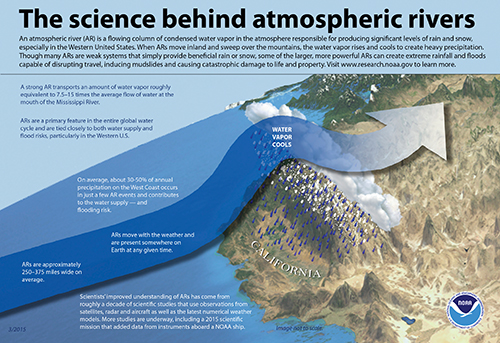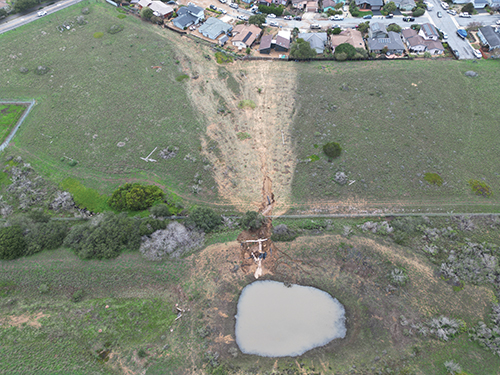The levee that broke at Vista Court. Photo by Bob Crizer
An atmospheric river storm Jan. 8-9 left a swath of muddy destruction in one Los Osos neighborhood after a levee on a storm retention pond failed and sent a torrent of goo downhill into some 20 homes on Vista Court, a cul-de-sac in the Vista De Oro subdivision.
Estero Bay News sought out what’s happened since that historic disaster.
Storm Drain System is Old
The pond is where storm runoff from the Cabrillo Estates — located uphill from Vista Court — collects through a series of storm drains in the streets. It’s an old system and the Community Services District is in charge of the retention pond and the County maintains the storm drains.
“The basin was built in two parts,” explained LOCSD General Manager Ron Munds. “The west end was constructed in 1972 and the east end where the failure occurred was built in 1994.” Essentially, it’s a basin within a bigger basin and it was that bigger basin that failed.
Normally with such earthen levees, water tops the levee and erodes it from the outside leading to failure. And once a levee or earthen dam starts to erode this way, it fails quickly. They aren’t sure yet if that’s what happened here.
In a recent interview, Munds said they were as yet unsure why the levee failed. “We’re still waiting for the report from the third party civil engineering firm hired by the insurance company that should answer this question,” Munds said.
Pond was Inspected
Everything seemed fine earlier that morning. “Staff did a visual inspection of the basin the morning of Jan. 9,” Munds said. “At that time there was no indication that a failure was imminent. It wasn’t a detailed inspection, just a check to see where the levels were in the basin.”
Later that morning the area was hit with a torrent of rain, which although brief, really opened up the sky and poured rain.
By around 11 a.m. the levee was failing. And a few minutes later the residents of Vista Court were deep into misery as the levee liquefied and mud rolled down hill. The failure left a gaping hole in the levee.
Almost immediately Los Osos residents rose to the occasion and through social media posts, a small army of volunteers turned out to help clean up, returning day after day to help their neighbors dig out.
No injuries or deaths were caused in the incident. It was truly an inspirational response by citizens, who also turned out to help stop flooding on Pine Avenue.
CSD Went to Work
The disaster sparked the CSD into action too. Within two days, the CSD board had called an emergency special meeting to discuss the matter, passing a resolution authorizing Munds to spend money making temporary repairs.
They came up with temporary repairs that so far have held up, even after several other storms have hit the area in this wet and miserable El Niño Winter.
“Basically,” Munds said, “we enlarged an existing berm within the basin to retain water on the west end of the basin.
“We cut down an existing overflow drain pipe to ensure if the water levels were going to top the temporary berm, it would overflow into the drain pipe and exit out onto Pecho Valley Road. The temporary repair has worked so far.”
But it hasn’t been without issues, as the overflow onto Pecho Valley Road (the road that leads to Montaña de Oro State Park) has at times been very heavy making vehicle travel a bit tricky.
Fix is on the Way
Munds said they hired a geo technical and engineering firm to design the temporary fix.
“Since there isn’t time to evaluate the entire north basin wall,” Munds said, “the design calls for a new plastic liner to cover not only the repair area but the entire wall. A more thorough analysis is needed to understand what is needed in the future. This temporary repair will ensure the wall will withstand any future storms until a permanent solution is ready.”
How that permanent solution will be paid for is, well, a little muddy. Munds said there used to be a maintenance assessment district in Cabrillo Estates but that was for street lighting and even it has since been dissolved.
“There is no Cabrillo assessment district,” Munds said. “There used to be one for lighting but that no longer exists.”
CSD Covering Its Losses

the county and beyond.
The CSD is turning to the Federal Emergency Management Agency (FEMA) for help with the repair costs but until that comes through, it’s pulling money out of just about every pocket it can find.
In a Feb. 2 report to the CSD board, Munds estimated the cost for both the temporary and permanent fixes.
One chart shows they spent $124,000 on the “interim/emergency repairs” that were performed by Hartzell Const., paying $3,000 to CSD employees for overtime, $25,500 for a consulting engineer and $96,000 to the contractor.
Costs for emergency permanent repairs were estimated at $623,000 — $88,450 for engineering consultant and $535,000 to do the actual repairs. So fixing the levee is expected to cost over $748,000, but the actual amount is likely to top $1 million.
“It is estimated,” Munds’ report reads, “that the District will need around $1 million, including a 20% contingency, to complete both the emergency interim and permanent repairs.”
That’s left the CSD tapping its reserve accounts to cover the costs until FEMA comes through. The storms of January were included in State and Federal disaster declarations, so FEMA should be good for it, but as anyone who has ever dealt with a disaster like this, it seems to take forever and isn’t enough.
The CSD plan is to use $234,000 in so-called Fund 800 reserves from the general fund. They also are tapping the vehicle/equipment replacement reserves; $210,00 from the general contingency reserves and $90,000 from the fire mitigation reserves totaling $500,000 from these three sources.
Spending the reserves is a simple matter of passing a resolution authorizing its use for something other than intended and a four-fifths approval vote.
Who’s to Blame
There’s also the issue of liability for all those people whose lives were turned upside down. “The insurance company brought in an adjuster,” Munds said, “which evaluated each home impacted. I haven’t seen a report yet on what the money value is; that should be part of what comes out shortly.”
The CSD is dealing with FEMA. “We are dealing with FEMA directly for the damage to the basin,” he said. “Homeowners worked with FEMA and state agencies directly when the Disaster Relief Center was open in SLO.”
Homeowners are also seeking help from the CSD, as starting Jan. 12, claims started coming in for damages to homes. So far the CSD has received at least 30 claims of damages from the Vista Court incident, ranging from “under $10,000,” to over half a million, to the cost of a home replacement.
Claims are Telling
Munds released redacted copies of these 1-page claim forms, which read like a litany of horrors.
“The first 2 ft. of entire home,” reads one claim from someone on Montana Way, “water damage in walls, flooring, cabinets, garage.”
Another reads, “The amount of damage to the property is unknown at this time. The property has been red tagged by the County as uninhabitable.”
Others simply read, “$500,000” and “$800,000.”
“Mud and water flowed into yard around perimeter of house,” reads another claim, “seeping in house and soaking carpet and baseboards. Removal of all carpet and mold mitigation.” That homeowner had to remove all the carpet, get the house mitigated for mold, which they said was $4,500 “and could be more.” They estimated new carpeting and flooring would cost over $15,000.
Another claim pegs the replacement of all the flooring at over $80,000.
And another claim reads, “Due to negligent maintenance of a public facility my house was red tagged as unsafe and uninhabitable. The structure property and all personal belongings were destroyed.”
And there’s this heart-breaking claim: “I cannot live in my home. Flooring, drywall, cabinets (kitchen and bath) window coverings, furniture, clothing, and outdoor landscaping have been damaged or destroyed. I need housing for me and my disabled son. I need funds to even begin the remediation process. I need my home cleaned, remediated, repaired and made habitable as quickly as possible.”




